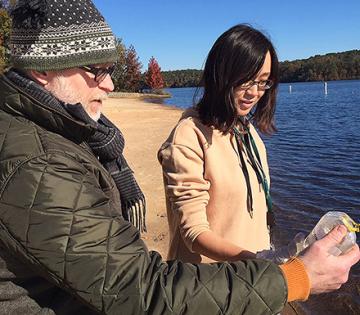Healthier Waterways, Healthier You

Microbiologist Jonathan Frye and University of Georgia and ARS research associate Sohyun Cho collect a water sample from the Upper Oconee watershed. Analysis of samples from the watershed will determine the levels of bacteria in waters around Athens, Georgia. (Elizabeth McMillan, D4067-1)
Ponds, streams, and rivers can be sources of pathogenic bacteria that can cause nasty intestinal illnesses in people who swallow the contaminated water.
Someone who understands this well is Sohyun Cho, a doctoral candidate at the University of Georgia and an Agricultural Research Service (ARS) research associate in Athens, Georgia. Cho saw the effects of contaminated water as a child living in India, where her father served as a Methodist missionary. In the 10 years she was there, it was not uncommon for friends and entire families to develop intestinal illnesses. The symptoms usually disappeared after a few days, and the illnesses usually went undiagnosed, but they were often attributed to contaminated drinking water from wells and rivers.
Inspired to pursue a Ph.D. in microbiology, Cho applied in 2014 to work with Jonathan Frye, a microbiologist with the ARS National Poultry Research Center in Athens. She wanted to study whether local waterways serve as reservoirs for Salmonella and other types of bacteria that can make people sick.
Frye was very interested, in part because past studies had shown that Salmonella and other bacteria such as E. coli may be spread by surface waters. His interest was also piqued because he and Charlene Jackson, another ARS microbiologist in Athens, were studying the environment’s role in spreading antimicrobial-resistant bacteria. One of their hypotheses is that surface waters are major contributors to the development and spread of antimicrobial resistance because of the variety of microbial life that flows into them from other areas. Their research has major implications for public health: The Centers for Disease Control and Prevention (CDC) estimates that at least 2 million people a year become infected with antibiotic-resistant bacteria and that at least 23,000 people die from those infections. Many more also die from conditions complicated by antibiotic-resistant infections, according to the CDC.
In 2015, Cho, Frye, and Jackson began studying bacterial levels in the waters around Athens. As part of the project, they tested water samples collected by the Upper Oconee Watershed Network, a volunteer group that has spent 20 years monitoring Athens-area waterways, where people kayak, swim, and fish. Samples had been collected from more than 100 sites covering 254 square miles in urban, suburban, industrial, and agricultural settings, as well as in old-growth forests.
Results from the work so far have found 496 different E. coli strains, or types, from the 458 collected water samples. Of more interest was that 34 of the E. coli types were resistant to one or more antimicrobial drugs.
Frye emphasized that the presence of E. coli should not cause concern about the quality of the Athens-area drinking water. The chlorine and ultraviolet light used to disinfect drinking water will kill E. coli along with any other harmful bacteria, he says.
The results also show the importance of the monitoring effort and how ARS scientists are helping to keep people in the area informed about the health of their waterways. — By Dennis O’Brien, ARS Office of Communications.

